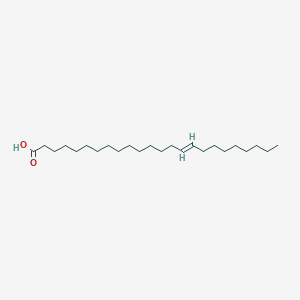| MeSH term | MeSH ID | Detail |
|---|---|---|
| Adrenoleukodystrophy | D000326 | 29 associated lipids |
| Zellweger Syndrome | D015211 | 39 associated lipids |
| Metabolic Syndrome | D024821 | 44 associated lipids |
Trans-selacholeic acid
Trans-selacholeic acid is a lipid of Fatty Acyls (FA) class. Trans-selacholeic acid is associated with abnormalities such as Obesity, Diabetes Mellitus, Non-Insulin-Dependent and Metabolic syndrome. The involved functions are known as Inflammation, Insulin Resistance and Synthesis. The associated genes with Trans-selacholeic acid are TNF gene and CCL2 gene. The related lipids are nervonic acid, palmitoleic acid and Sphingolipids.
Cross Reference
Introduction
To understand associated biological information of Trans-selacholeic acid, we collected biological information of abnormalities, associated pathways, cellular/molecular locations, biological functions, related genes/proteins, lipids and common seen animal/experimental models with organized paragraphs from literatures.
What diseases are associated with Trans-selacholeic acid?
Trans-selacholeic acid is suspected in Obesity, Diabetes Mellitus, Non-Insulin-Dependent, Metabolic syndrome and other diseases in descending order of the highest number of associated sentences.
Related references are mostly published in these journals:
| Disease | Cross reference | Weighted score | Related literature |
|---|
Possible diseases from mapped MeSH terms on references
We collected disease MeSH terms mapped to the references associated with Trans-selacholeic acid
PubChem Associated disorders and diseases
What pathways are associated with Trans-selacholeic acid
There are no associated biomedical information in the current reference collection.
PubChem Biomolecular Interactions and Pathways
Link to PubChem Biomolecular Interactions and PathwaysWhat cellular locations are associated with Trans-selacholeic acid?
There are no associated biomedical information in the current reference collection.
What functions are associated with Trans-selacholeic acid?
Related references are published most in these journals:
| Function | Cross reference | Weighted score | Related literatures |
|---|
What lipids are associated with Trans-selacholeic acid?
Related references are published most in these journals:
| Lipid concept | Cross reference | Weighted score | Related literatures |
|---|
What genes are associated with Trans-selacholeic acid?
Related references are published most in these journals:
| Gene | Cross reference | Weighted score | Related literatures |
|---|
What common seen animal models are associated with Trans-selacholeic acid?
There are no associated biomedical information in the current reference collection.
NCBI Entrez Crosslinks
All references with Trans-selacholeic acid
Download all related citations| Authors | Title | Published | Journal | PubMed Link |
|---|---|---|---|---|
| pmid: | ||||
| Mizushina Y et al. | Mode analysis of binding of fatty acids to mammalian DNA polymerases. | 2000 | Biochim. Biophys. Acta | pmid:10903472 |
| Mizushina Y et al. | Structural homology between DNA binding sites of DNA polymerase beta and DNA topoisomerase II. | 2000 | J. Mol. Biol. | pmid:11090281 |
| Kasai N et al. | Three-dimensional structural model analysis of the binding site of an inhibitor, nervonic acid, of both DNA polymerase beta and HIV-1 reverse transcriptase. | 2002 | J. Biochem. | pmid:12417034 |
| Agazzi ME et al. | In-house validation of an improved sample extraction and clean-up method for GC determination of isomers of nervonic acid in meat products. | 2003 | Anal Bioanal Chem | pmid:12732919 |
| Bettger WJ et al. | Nervonic acid is transferred from the maternal diet to milk and tissues of suckling rat pups. | 2003 | J. Nutr. Biochem. | pmid:12742544 |
| FULCO AJ and MEAD JF | The biosynthesis of lignoceric, cerebronic, and nervonic acids. | 1961 | J. Biol. Chem. | pmid:13702539 |
| Weidner E and Findley A | Catalase in microsporidian spores before and during discharge. | 2003 | Biol. Bull. | pmid:14583549 |
| Sala-Vila A et al. | The source of long-chain PUFA in formula supplements does not affect the fatty acid composition of plasma lipids in full-term infants. | 2004 | J. Nutr. | pmid:15051839 |
| Chen JR et al. | Dietary patterns and blood fatty acid composition in children with attention-deficit hyperactivity disorder in Taiwan. | 2004 | J. Nutr. Biochem. | pmid:15302081 |
| Kasai N et al. | Sulfoquinovosylmonoacylglycerol inhibitory mode analysis of rat DNA polymerase beta. | 2005 | FEBS J. | pmid:16128805 |
| Erkkilä AT et al. | Association between school performance, breast milk intake and fatty acid profile of serum lipids in ten-year-old cleft children. | 2005 | J Craniofac Surg | pmid:16192854 |
| Oda E et al. | Relationships between serum unsaturated fatty acids and coronary risk factors: negative relations between nervonic acid and obesity-related risk factors. | 2005 | Int Heart J | pmid:16394593 |
| Singh B et al. | Isolation, structure elucidation and in vivo hepatoprotective potential of trans-tetracos-15-enoic acid from Indigofera tinctoria Linn. | 2006 | Phytother Res | pmid:16841368 |
| Murakami S et al. | Site-directed mutational analysis of structural interactions of low molecule compounds binding to the N-terminal 8 kDa domain of DNA polymerase beta. | 2006 | Biochem. Biophys. Res. Commun. | pmid:16996474 |
| Odabasi E et al. | Lipophilic components of different therapeutic mud species. | 2007 | J Altern Complement Med | pmid:18166123 |
| Guo Y et al. | Increase in nervonic acid content in transformed yeast and transgenic plants by introduction of a Lunaria annua L. 3-ketoacyl-CoA synthase (KCS) gene. | 2009 | Plant Mol. Biol. | pmid:19082744 |
| Yang J et al. | Study of the inhibitory effect of fatty acids on the interaction between DNA and polymerase beta. | 2009 | Biochemistry Mosc. | pmid:19747104 |
| Taylor DC et al. | Molecular cloning and characterization of a KCS gene from Cardamine graeca and its heterologous expression in Brassica oilseeds to engineer high nervonic acid oils for potential medical and industrial use. | 2009 | Plant Biotechnol. J. | pmid:19843251 |
| Vluggens A et al. | Reversal of mouse Acyl-CoA oxidase 1 (ACOX1) null phenotype by human ACOX1b isoform [corrected]. | 2010 | Lab. Invest. | pmid:20195242 |
